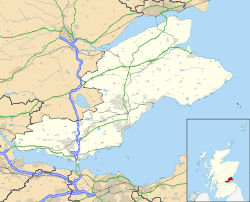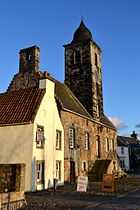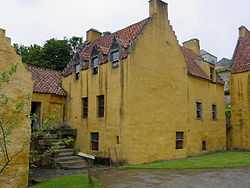Culross
| Culross | |
| Scottish Gaelic: Cuileann Ros | |
| Scots: Culross | |
| Culross and the Firth of Forth |
|
 Culross |
|
| Population | 395 [1] |
|---|---|
| Council area | Fife |
| Lieutenancy area | Fife |
| Country | Scotland |
| Sovereign state | United Kingdom |
| Police | Scottish |
| Fire | Scottish |
| Ambulance | Scottish |
| EU Parliament | Scotland |
| UK Parliament | Dunfermline and West Fife |
| Scottish Parliament | Dunfermline |
Coordinates: 56°03′19″N 3°37′45″W / 56.0554°N 3.6293°W
Culross (/ˈkurəs/) (Gaelic: Cuileann Ros) is a village and former royal burgh in Fife, Scotland.
According to the 2006 estimate, the village has a population of 395.[1] Originally Culross served as a port city on the Firth of Forth and is believed to have been founded by Saint Serf during the 6th century.
Founding legend
A legend states that when the British princess (and future saint) Teneu, daughter of the king of Lothian, became pregnant before marriage, her family threw her from a cliff. She survived the fall unharmed, and was soon met by an unmanned boat. She knew she had no home to go to, so she got into the boat; it sailed her across the Firth of Forth to land at Culross where she was cared for by Saint Serf; he became foster-father of her son, Saint Kentigern or Mungo (d. 612).
Industry
During the 16th and 17th centuries, the town was a centre of the coal mining industry. Sir George Bruce of Carnock, who built the splendid 'Palace' of Culross and whose elaborate family monument stands in the north transept of the Abbey church, established at Culross, the first coal mine in the world to extend under the sea, in 1575. The mine worked what is now known as the Upper Hirst coal seam, with ingenious contrivances to drain the constant leakage from above. This mine was considered one of the marvels of the British Isles in the early 17th century, until it was destroyed in a storm, in 1625.[2]
Culross' secondary industry was salt panning. There was a considerable export trade by sea in the produce of these industries and the prevalence of red roof tiles in Culross and other villages in Fife is thought to be a direct result of collier ships returning to Culross with Dutch roof tiles as ballast. The town was also known for its monopoly on the manufacture of 'girdles', i.e. flat iron plates for baking over an open fire.[3] The town's role as a port declined from the 18th century, and by Victorian times it had become something of a 'ghost town'. The harbour was filled in and the sea cut off by the coastal railway line in the second half of the 19th century (though the site of the harbour walls can to a large extent still be traced).
Heritage



During the 20th century, it became recognised that Culross contained many unique historical buildings and the National Trust for Scotland has been working on their preservation and restoration since the 1930s.
Notable buildings in the burgh include Culross Town House, formerly used as a courthouse and prison, the 16th century Culross Palace, 17th century Study, and the remains of the Cistercian house of Culross Abbey, founded 1217. The tower, transepts and choir of the Abbey Church remain in use as the parish church, while the ruined claustral buildings are cared for by Historic Scotland. Just outside the town is the 18th-century Dunimarle Castle, built by the Erskine family to supersede a medieval castle.
Thomas Cochrane, 10th Earl of Dundonald spent much of his early life in Culross, where his family had an estate. There is now a bust in his honour outside the Culross Town House. He was the first Vice Admiral of Chile.
Notable people
- Elizabeth Melville, "Lady Culross" (c.1578 - c.1640), Scotland's earliest known published female poet
- Stewart McPherson, recipient of the Victoria Cross
- Jackie Sinclair, Scottish international footballer
- Rev Robert Pont (1525-1606) radical church figure during the Reformation, five times Moderator of the Church of Scotland
Civic links
Culross is twinned with Veere in the Netherlands, which was formerly the port through which its export goods entered the Low Countries.[4]
It is within the Dunfermline and West Fife Westminster Parliamentary constituency.
Culross as a location for filming
Several motion pictures have used Culross as a location, including The Little Vampire (2000 feature film),[5] The 39 Steps,[6] Kidnapped A dying Breed,[7] and Captain America: The First Avenger.
References
- ↑ 1.0 1.1 "Population Estimates for Towns and Villages in Fife" (PDF). Fife Council. March 2008. Retrieved 2009-12-05.
- ↑ "Culross". Undiscovered Scotland. 2002–2009. Retrieved 8 Sep 2009.
- ↑ "Hearth and Home". Fife Folk Museum. Retrieved 2009-04-05.
- ↑ "The Scottish Staple at Veere". Retrieved 2009-02-01.
- ↑ http://www.scotlandthemovie.com/movies/vampcul.html
- ↑ http://www.imdb.com/title/tt1282016/locations
- ↑ http://www.imdb.com/title/tt1058522/
External links
| Wikimedia Commons has media related to Culross. |